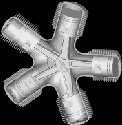|
one thing that occurred to me on a rewatch of the latest episode - waiting for the lead bomber to drop their bombs. Is the bombardier in the lead plane responsible for aiming the entire formation's bombs, and the other bombers just drop blindly assuming that because they're in position they'll hit the target area? Or is every bombardier taking individual aim and they're just waiting for permission to drop out of some sort of protocol?
|
|
|
|

|
| # ? May 24, 2024 14:40 |
|
Eau de MacGowan posted:one thing that occurred to me on a rewatch of the latest episode - waiting for the lead bomber to drop their bombs. Is the bombardier in the lead plane responsible for aiming the entire formation's bombs, and the other bombers just drop blindly assuming that because they're in position they'll hit the target area? Or is every bombardier taking individual aim and they're just waiting for permission to drop out of some sort of protocol? From how I understand it, the lead bombardier is the one who decides when the bombs drop. The way how the Norden bomb sight works is that it ties into the plane's autopilot. So the bombardier is actually flying the lead plane with the bomb sight. He gets all the dials set right for the altitude and airspeed and adjusts for the wind so that the bomb sight keeps the target in the crosshairs without drifting. The bomb sight itself is what drops the bombs. When it gets to the right angle to the target that the bombs should hit it, it drops the bombs. Obviously, not every plane in the formation can do this, because you could end up with the planes bumping into each other. So I assume that every other plane in the formation leaves control of the plane to the pilots to remain in formation while the lead bombardier gets everyone set on the right path. Then when the lead plane automatically drops the bombs, the other planes manually drop their bombs.
|
|
|
|
Still holding out hope that Band of Brothers through The Pacific through the first five episodes of Masters of Air was all an incredibly complicated delivery mechanism for it to turn into a remake of Hogan's Heroes.
|
|
|
|
I have no idea what Hogan's Heroes is but I just imagined the last Masters of the Air episode post credit scene being Sledge coming in to invite Buck into the PTSD initiative.
|
|
|
|
Cojawfee posted:From how I understand it, the lead bombardier is the one who decides when the bombs drop. The way how the Norden bomb sight works is that it ties into the plane's autopilot. So the bombardier is actually flying the lead plane with the bomb sight. He gets all the dials set right for the altitude and airspeed and adjusts for the wind so that the bomb sight keeps the target in the crosshairs without drifting. The bomb sight itself is what drops the bombs. When it gets to the right angle to the target that the bombs should hit it, it drops the bombs. Obviously, not every plane in the formation can do this, because you could end up with the planes bumping into each other. So I assume that every other plane in the formation leaves control of the plane to the pilots to remain in formation while the lead bombardier gets everyone set on the right path. Then when the lead plane automatically drops the bombs, the other planes manually drop their bombs. This is how you end up with Creepback, where the lead bomber drops and everyone starts dropping earlier and earlier. It was less of a problem during the day raids.
|
|
|
|
kiminewt posted:I have no idea what Hogan's Heroes is It finally happened: https://www.youtube.com/watch?v=NChPewIs0js Hogan's Heroes was a sitcom about American POWs in a German Prisoner of War camp famed for never having a successful escape, but actually using it as a cover to connect with Resistance Networks to aid bombing and sabotage operations and to aid prisoners from other camps to escape through a series of underground tunnels. It was a controversial subject for a show initially but proved very popular, and had a number of Jewish actors who were cast with the agreement that the Nazis would always be the butt of the jokes, made to look incompetent or corrupt. The titular character was an American Air Force Colonel running a crew of Allied soldiers - British, French, American - played by Bob Crane who was a weird loving dude, and I also recommend the movie Autofocus for a look at his life and death (murder).
|
|
|
|
How realistic was that dogfighting scene? I guess it was never usually an option due to flying in formation.
|
|
|
|
I imagine that with the limitations of 1943 navigation, deviating from your waypoints to do some wild maneuverers is gonna cost you fuel, altitude, and location uncertainty. Imagine trying to fly 300 miles dead reckoning but your starting location is +/- 40 miles. Not as much of a worry with short range fighters, as the inaccuracies don't add up as much when you're in sight of England or the bomb group you're escorting.
|
|
|
|
|
I honestly have no idea how the navigator can figure out where the planes are, i'm old enough to remember a time before GPS, but even then I hated maps.
|
|
|
|
Speed, time, a slide rule, and the occasional visual landmark. Radio beacon navigation was the new cool thing in 1943 with LORAN and Gee, but those weren't widespread or ubiquitous.
|
|
|
|
|
Junkenstein posted:How realistic was that dogfighting scene? I guess it was never usually an option due to flying in formation. Ups and downs but nothing egregious. Mostly I was wondering how the side gunners weren't getting tossed around when Rosenthal made those super sharp banks.
|
|
|
|
Eau de MacGowan posted:one thing that occurred to me on a rewatch of the latest episode - waiting for the lead bomber to drop their bombs. Is the bombardier in the lead plane responsible for aiming the entire formation's bombs, and the other bombers just drop blindly assuming that because they're in position they'll hit the target area? Or is every bombardier taking individual aim and they're just waiting for permission to drop out of some sort of protocol? The process changed over the course of the war--early on, every bombardier was aiming individually. As time went on, the procedure went to drop on the leader's drop.
|
|
|
|
Oasx posted:I honestly have no idea how the navigator can figure out where the planes are, i'm old enough to remember a time before GPS, but even then I hated maps. They had a bunch of instruments to allow them to measure things like wind and heading which, in turn, allowed them to measure their groundspeed. Groundspeed + heading + time = location, provided you knew where you were at one point.
|
|
|
|
M_Gargantua posted:Speed, time, a slide rule, and the occasional visual landmark. I know it's more complicated than I'm putting it, but I did laugh when Crosby is asked for a heading and gives up on the maps for the moment and runs over to look out the window
|
|
|
|
He managed to hit the one tree in East Anglia
|
|
|
|
Arc Hammer posted:Ups and downs but nothing egregious. Mostly I was wondering how the side gunners weren't getting tossed around when Rosenthal made those super sharp banks. A B-17 isn't a nimble fighter, so I am guessing he was doing his best to do positive G maneuvers so the gunners would mostly be pushed down and not thrown around too much.
|
|
|
|
Junkenstein posted:How realistic was that dogfighting scene? I guess it was never usually an option due to flying in formation. Spawn in a B17 in War Thunder and see for yourself how well slowing down and presenting a larger surface area to aim at would go for you. 
|
|
|
|
Oasx posted:I honestly have no idea how the navigator can figure out where the planes are, i'm old enough to remember a time before GPS, but even then I hated maps. https://www.303rdbg.com/crew-duties.html quote:The navigator's job is to direct your flight from departure to destination and return. He must know the exact position of the airplane at all times.
|
|
|
XYZAB posted:Spawn in a B17 in War Thunder and see for yourself how well slowing down and presenting a larger surface area to aim at would go for you. I imagine leading an erratically moving target is a bit harder when your viewpoint is locked firmly inside your cockpit and you don't have a magic floating circle in the sky telling you exactly where your bullets will go  With the rest of the flight gone, there was really no reason for the pilot to not try evading.
|
|
|
|
|
There's a eastern theater crew who were known to go out of their way to do pretty much exactly that. https://www.youtube.com/watch?v=7Iuq3Wfz3RA
|
|
|
|
Interesting, thanks!
|
|
|
|
XYZAB posted:Spawn in a B17 in War Thunder and see for yourself how well slowing down and presenting a larger surface area to aim at would go for you. A larger surface area that has 2-3 aimable machine guns on it. He was pointing the guns at the planes.
|
|
|
|
THF13 posted:There's a eastern theater crew who were known to go out of their way to do pretty much exactly that. oh god a white guy covered in norse tattoos the algorithm's going to be recommending me pro-rhodesia videos for the next six months
|
|
|
|
THF13 posted:There's a eastern theater crew who were known to go out of their way to do pretty much exactly that. this guy is so full of poo poo edit : for context - he claims they not only doubled the amount of .50 cal guns on the plane with 3 "spares" but also somehow dropped 2000lbs in weight and thats only part of the nonsense he goes on about 
ded fucked around with this message at 11:40 on Feb 21, 2024 |
|
|
|
I started watching Rogue Heroes because of this thread and I really enjoyed it. Wildly different in tone, complete with anachronistic needle drops, but a super fun watch. If either of these shows are to be believed, it seems like 25% of all British casualties in wwii were related to bar fights.
|
|
|
|
Broadlybrowsing posted:I started watching Rogue Heroes because of this thread and I really enjoyed it. Wildly different in tone, complete with anachronistic needle drops, but a super fun watch. I think the show has done a pretty good job of showing the yin/yang part of a bomber crew's life to where it was warm bed and good accommodations at the beginning and end of the day mixed with abject terror and horrific conditions during the middle of it. That kind of duality and suddenness had to be a hell of a hard thing to manage.
|
|
|
ded posted:this guy is so full of poo poo I mean I skipped the video and just read the wikipedia article and all that is in the wiki article too. Apparently they got rid of a ton of stuff they considered non-essential and swapped out the engines for something faster as well as increasing the .50 cals by making some of the gunnery stations twin .50 cals instead of single.
|
|
|
|
|
I'm surprised that, in virtually no war media, have I ever seen an air crew land and proceed to smack around the ground crew for having screwed something up. I simply do not believe that this scenario did not happen in war time. Instead I'm amazed that there has been some sort of treaty for ~100 years wherein everybody pretends there was infinite respect and no emotions ever run hot.
|
|
|
|
Most war media is, to some extent, also propaganda. Sure, you also have films like Platoon that are not, but those are relatively rare. That goes double for a war like ww2: think of all the depictions of war how many you see portray rape, for example, which by all historical accounts was very common on all sides. Anything air force related is going to be even more so the case. Because at that point you likely need official support of some form to be able to even film the thing. Masters of the air for example was supported by the National Museum of the Mighty Eighth Air Force. Masters of the air at least showed one plane going down in training, which is more than most other media. But you're never going to see a genuine portrayal of just the magnitude of deaths in training or due to mechanical failure.
|
|
|
|
Eau de MacGowan posted:one thing that occurred to me on a rewatch of the latest episode - waiting for the lead bomber to drop their bombs. Is the bombardier in the lead plane responsible for aiming the entire formation's bombs, and the other bombers just drop blindly assuming that because they're in position they'll hit the target area? Or is every bombardier taking individual aim and they're just waiting for permission to drop out of some sort of protocol? If every plane aims for the same DMPI (desired mean point of impact), the entire formation will crunch up over the target, with understandably undesirable results. That is why everyone in the formation drops when the lead bombardier drops. The German fighters would target the lead planes for this reason. Imagine the OH CRAP WHAT NOW?! of losing your lead bombardier when you’re on the run-in and 30-60 seconds from dropping bombs.
|
|
|
|
Honestly, when the bombardier was waiting I thought the lead plane was a dead stick with everyone in the nose section dead and the plane was stuck on autopilot.
|
|
|
|
I agree with Elvis, that dude’s sheepskin jacket was ugly as hell.
|
|
|
|
1988 Brit miniseries 'Piece of Cake' (which I think has already been mentioned in this thread) is worth checking out for being one of the few TV productions about WW2 aviators that isn't complete hagiography, with the featured fighter squadron including at least one obvious sociopath and most of the rest being obviously unfit for duty in one way or another (as the series continues there is another pilot who is obviously rapidly going insane and losing his grip on reality, but they keep him flying anyway because he's experienced and there's no one to replace him with).
|
|
|
|
Haha yeah, the one who decides to start flying his plane upside down during the Battle of Britain.
|
|
|
|
MrMojok posted:Haha yeah, the one who decides to start flying his plane upside down during the Battle of Britain. Uh, Lieutenant, what were you doing there? Communicating. Keeping up foreign relations. I was uh, you know, giving him the bird.
|
|
|
|
GolfHole posted:I'm surprised that, in virtually no war media, have I ever seen an air crew land and proceed to smack around the ground crew for having screwed something up. I've never seen anything on it in any secondary source or first-person account. This is likely due to the fact that the same ground crew will be servicing your plane before your next flight.
|
|
|
|
I can remember a few times that crew chief Tyrol and thr viper pilots got into scraps over the conditions of their vipers in the 2000s Battlestar Gaalctica, if you want to extend into the realm of science fiction.
|
|
|
|
My knowledge of that is limited to the 1970s tv show Baa Baa Black Sheep. Because of this I believe it was the other way around… the aircraft crew chief was the one who beat the poo poo out of the pilots.
|
|
|
MrMojok posted:Haha yeah, the one who decides to start flying his plane upside down during the Battle of Britain. Insanity aside, wouldn't that be an incredibly stupid idea on account of most British planes using float carbs at the time?
|
|
|
|
|

|
| # ? May 24, 2024 14:40 |
|
I thought it was a neat detail that you saw the little candy and gum dispensers that USAAF crews had on the dashboard of one of the bombers in a shot.
|
|
|






































